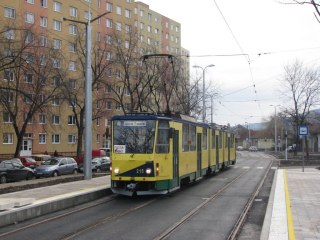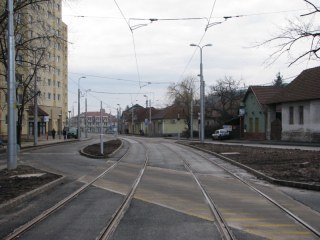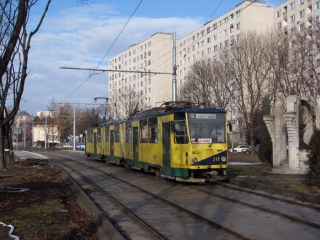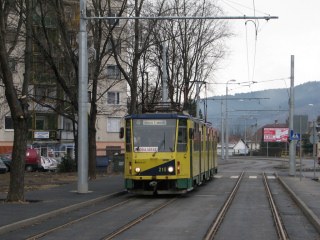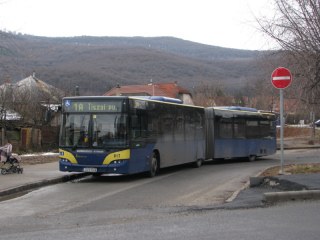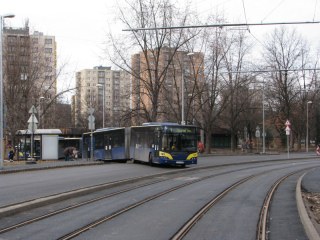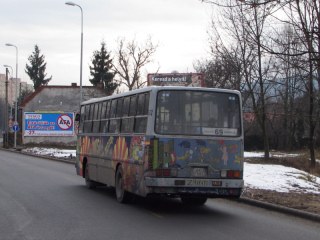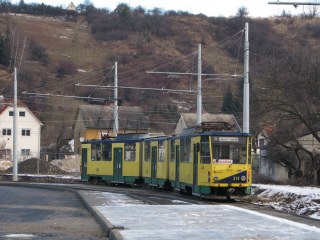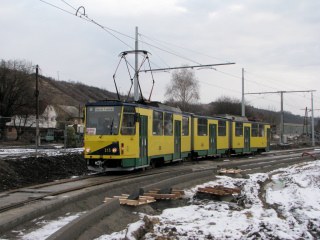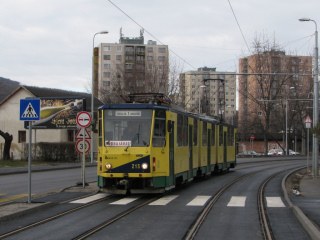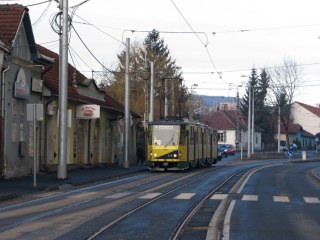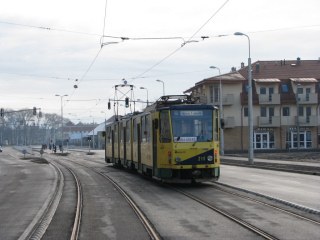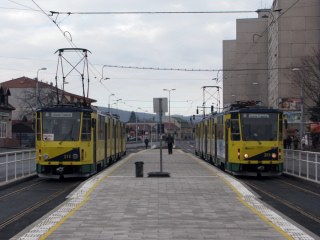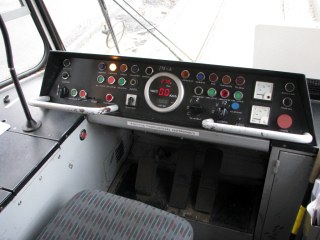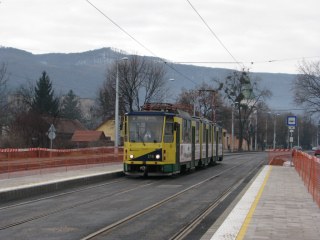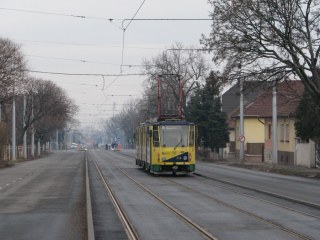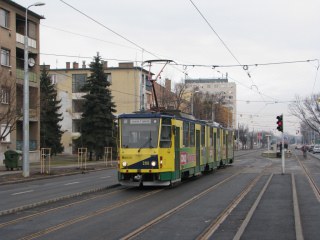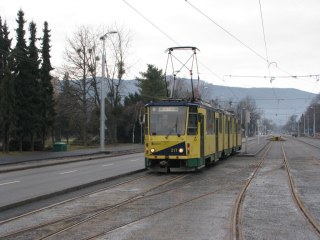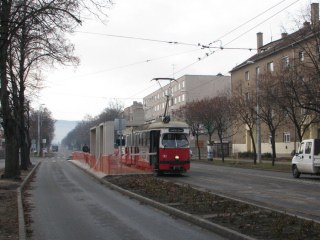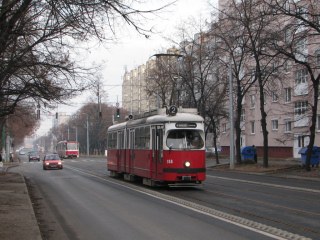budapest
other hungarian
close-up
lost rails
other countries
Miskolc: before the tram extension went into use
Hier geht's zur deutschsprachigen Version / Kattints ide a magyar változathoz
I've heard about the formal acceptance review of tram line 1's extension taking place on January 9, and that they will also be doing driver training on the new stretch that day - I thought these were two good reasons to go there, and I also managed to get a ride to Miskolc.
Before I continue with the pictures taken that day, here's some information for those who are not familiar with this extension. The opening of the new stretch concludes a full renovation and modernisation of Miskolc's existing tram line 1. The new section is 1.5 kilometers long and includes three new stops, with the last being a large reversing loop right next to the depot of the narrow-gauge forest railway to Lillafüred/Garadna. The whole project will be complete with the arrival of 31 low-floor trams, which will be supplied by Skoda (who received the order after the winner of the umpteenth request for tender, AnsaldoBreda was ruled out in favour of Ganz-Skoda) in 2014/2015. Although Miskolc might seem like a small one-line tramway system with line 2 just being a complementary service turning back at about 2/3rd the way via a single-track loop passing-by the entrance of a (now defunct) steel factory (Vasgyár), the tram is a vital element in the city's life with 32 million annual passengers (to 170,000 inhabitants). This means the modernisation and extension is a very positive thing, possibly saving the tram from a slow demise due to local financial problems.
Bölcs utca, the first new stop with Tatra KT8D5 number 215. This tram was built in 1990 for Most in Czechoslovakia, and came to Miskolc in 1997. The current fleet only includes second-hand vehicles: KT8D5 artics from Most and Kosice, and SGP E1 from Vienna.
To the left: on the way to the next stop, Alsó-Majláth/Köln utca. The surroundings of the new tracks were not yet finished, but the works needed for passenger usage (completion of stops and sidewalks) were done during the next one week, with the rest being done once the weather will get better. To the right: a detail of the overhead wire - a section insulator with power feed to the two sides of it.
To the left: the last piece of straight tracks in Felső-Majláth before the reversing loop starts. To the right: a bus of route 1A at its terminus at Felső-Majláth. The tram extension in its final form will replace parallel running bus lines 1 and 1A.
On the previous picture of the bus 1A it seems the terminus is located in a small mountain village. To the left we see the same place from another perspective. It's much more urban this way, isn't it? :) This place is in a valley getting more and more narrow as we go west. One side of the street is a small village, the other is stacked with ten-story apartment houses, so the character can be quite different depending on which angle you take your photos from. To the right: this bus was decorated by children - I thought it looked a bit weird.
The large reversing loop was the part most further away from being complete: a bus station (terminus) will be put in the middle of it, plus there's also a nice old building in there, badly avaiting renovation. Until the whole facility is complete, provisional platforms will be used, but the reversing loop itself can already be utilized.
This is the other side of the valley. Between the tram tracks and the hill there are only a few houses and the narrow-gauge railway.
In fact this whole area belonged to the depot of the forest railway, so on both its ends you'll see carbarns, stored coaches and workshop facilities. The unused old house also belonged (belongs?) to the forestry - the owner of the railway. On the left side of this panorama you can see the small but nice station building.
The end of the two-track section of the loop (left), and the place where (I guess) the boarding will took place (right). I mean the wide one in the background, with the white tactile strip.
To the left: the bend as the tracks leave Felső-Majláth and go east towards Diósgyőr városközpont. To the right: the yet unfinished stop Alsó-Majláth.
The biggest problem during planning was how to overcome the bottleneck right after Diósgyőr városközpont. Many said it can't be done, others that it musn't be done, while some proposed the usage of gauntleted tracks. Then it was decided that one track will share the road surface for about two hundred meters with vehicular traffic (as seen on the left). To the right: here, a row of houses was knocked down so the road could be widened, meaning that the shared track could be constrained to a minimal length.
This is Diósgyőr városközpont (Diósgyőr centre, a few hundred meters away from the ruins of the old royal castle), the terminus of tram line 1 until January 16. The former terminus building and platform roof had had to be torn down, because they were in the way of the extension, and the new roof was not yet installed. The scissors crossover of this facility was also replaced with a simple crossover.
As a reminisence, here's a panorama of the old terminus.
Riding the tram on the new tracks. It was very nice to ride two brand new tram stretches within one week - the other being route 2 of Szeged.
To the left: number 215 going for yet another turn on the new stretch. To the right: the dashboard of a Tatra KT8D5.
Let's take a look at the already existing parts of route 1! I knew everything was completely rebuilt, but it was a surprise that they opted for paved Phoenix rails instead of the sleepered tracks used earlier.
The stop Diósgyőri Gimnázium received a stub third track - this will be the terminus of an intermediate service called 1A.
The ex-Viennese E1 tramcars will be phased out when the new low-floor trams will arrive. I'm not sure what will happen to the KT8D5, though.
And here's another video, also showing other parts of the tram network. Our visit was quite short this time, as we also wanted to go to Debrecen to see how they're progressing with the extension of their tram network. But that will be the subject for antoher page.
I would hereby like to thank the employees of the municipal transportation company MVK Zrt, especially dr. Attila Bíró and Ágnes Csontos for their help!
Back to the top Back to the main page
